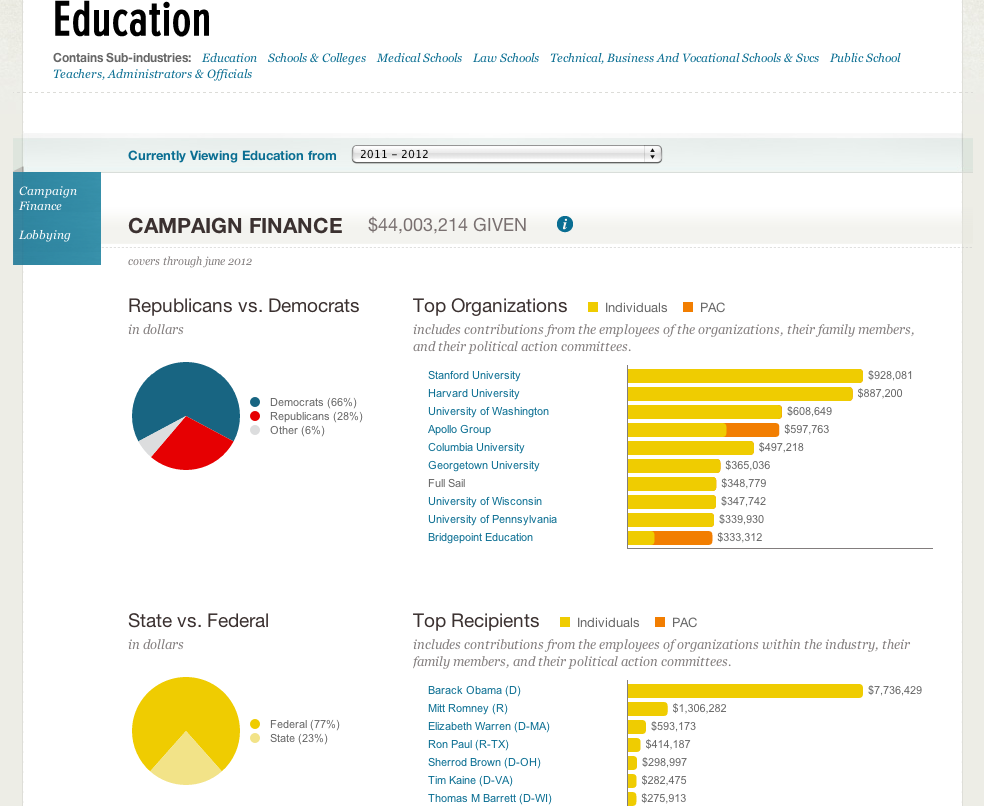Influence Explored: Education Sector Contributes Millions to Presidential Race
 With the Higher Education Opportunity Act up for renewal in 2013, either President Obama or Mitt Romney will need to address higher education, particularly funding and student loans. And although neither campaign has placed much focus on higher education, both candidates touched on the issue during the Presidential debates.
With the Higher Education Opportunity Act up for renewal in 2013, either President Obama or Mitt Romney will need to address higher education, particularly funding and student loans. And although neither campaign has placed much focus on higher education, both candidates touched on the issue during the Presidential debates.
An article in Inside Higher Ed details the differences between Obama’s and Romney’s proposed education policies.
During his campaign, Obama has said he will protect Pell Grants and maintain the maximum amount given to each student. Romney has indicated that he’d like to shrink that program. Additionally, Obama has proposed a plan to decrease monthly student loan payments and forgive student loans sooner, while Romney opposes loan forgiveness.
Both candidates would likely continue to provide federal funding for research, particularly for scientific research. They do, however, differ greatly on for-profit colleges and regulation of the education sector.
Because the education sector has a lot riding on this election, those interested in the future of higher education take multiple steps to secure funding for universities and students. First of all, employees of universities donate to political campaigns — the education sector has made more than $400 million in campaign contributions to Federal candidates and PACs so far this election cycle.
In the Presidential race, the industry appears to favor President Obama. So far this cycle, the President has received almost $8 million from the education interests, and Mitt Romney has received more than $1 million. Here’s a look at how a few schools have contributed:
- The University of Arizona was cited in a recent College Board report as one of the worst state schools at keeping tuition costs down over the past few years. Employees of the school and their family members have donated more than $100,000 to political campaigns and PACs. They donated over $56,000 to President Obama and his Victory Fund, and about $7,000 to Mitt Romney and his joint fundraising committee.
- Harvard University, which has one of the largest endowments in the country, is one of the top university contributors to campaigns. Employees of the university and their family members have contributed almost $2 million to campaigns and PACs. They have donated almost $700,000 to Obama and his victory fund, and given about $150,000 to Romney and his fundraising committee.
- Full Sail University, a for-profit university, received praise from Mitt Romney during the campaign season. Full Sail employees have contributed about $200,000 to presidential, congressional and state-level campaigns. Only $500 of that money went to Obama. Romney received $65,000.
Universities also take steps to ensure that they receive funding for research. One such way is by placing employees on the advisory committees for Federal foundations that provide research grants, like the National Science Foundation. While funding for scientific research would likely be maintained by either candidate, Lee Drutman of the Sunlight Foundation found that such funding is concentrated in schools with employees on NSF committees. Here’s a look at the same three universities’ involvement in advisory committees:
- The University of Arizona has 107 people on 31 National Science Foundation committees, 5 people on 5 Department of Health and Human Services committees, and 3 people on one National Endowment for the Humanities. According to Drutman’s research on the NSF, between 2008 and 20011, Arizona received an average of $51.7 million per year with 111 representatives on committees.
- Harvard University has 54 people on 26 National Science Foundation committees, 1 people on 13 Department of Defense committees, and 3 people on 3 Department of Health and Human Services committees. According to Drutman, Harvard averaged at $39.4 million annually from the NSF with 61 employees on committees.
- No data was found on Full Sail University and advisory committees.
‘Influence Explored’ takes an article from the day’s headlines and exposes the influential ways of the entities mentioned in the article. Names and corporations are run through Sunlight’s influence tracking tools such as Influence Explorer to remind readers of the money that powers Washington.

